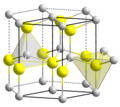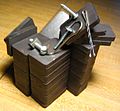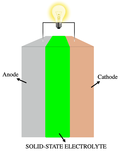Ceramic chemistry studies the relationship between the physical and chemical properties of fired ceramic bodies and ceramic glazes. The field is largely... 589 bytes (47 words) - 17:50, 15 April 2024 |
polarized light microscopy Ceramic chemistry, the chemistry of ceramics and glazes All pages with titles containing ceramic This disambiguation page lists... 1 KB (225 words) - 06:00, 11 October 2021 |
Quantum chemistry, also called molecular quantum mechanics, is a branch of physical chemistry focused on the application of quantum mechanics to chemical... 19 KB (2,130 words) - 06:52, 12 February 2024 |
 | Materials science (redirect from Materials Chemistry) solid-state physics and solid-state chemistry Nanotechnology Mineralogy Supramolecular chemistry Biomaterials science American Ceramic Society ASM International... 62 KB (6,522 words) - 13:28, 17 April 2024 |
 | Ceramic nanoparticle is a type of nanoparticle that is composed of ceramics, which are generally classified as inorganic, heat-resistant, nonmetallic... 10 KB (1,100 words) - 19:11, 22 April 2024 |
Electrolyte (redirect from Ceramic electrolyte) inert ceramic phase is introduced. There are two major classes of such electrolytes: polymer-in-ceramic, and ceramic-in-polymer. Solid ceramic electrolytes... 32 KB (3,430 words) - 11:13, 11 April 2024 |
proportion of processes, the residual glass phase often remains. Glass-ceramic materials share many properties with both glasses and ceramics. Glass-ceramics... 27 KB (3,555 words) - 17:45, 7 March 2024 |
 | Aluminium oxide (redirect from Alumina ceramic) insulator but has a relatively high thermal conductivity (30 Wm−1K−1) for a ceramic material. Aluminium oxide is insoluble in water. In its most commonly occurring... 31 KB (3,176 words) - 16:48, 19 March 2024 |
 | Pottery (redirect from Ceramic ware) The definition of pottery, used by the ASTM International, is "all fired ceramic wares that contain clay when formed, except technical, structural, and... 89 KB (11,227 words) - 08:11, 12 April 2024 |
Ceramic forming techniques are ways of forming ceramics, which are used to make everything from tableware such as teapots to engineering ceramics such... 9 KB (1,267 words) - 11:23, 22 March 2024 |
Solid-state chemistry, also sometimes referred as materials chemistry, is the study of the synthesis, structure, and properties of solid phase materials... 24 KB (2,730 words) - 15:13, 12 April 2024 |
 | Solid (section Solid-state chemistry) concerned with the physical and chemical properties of solids. Solid-state chemistry is especially concerned with the synthesis of novel materials, as well... 40 KB (5,362 words) - 02:15, 1 April 2024 |
 | A ceramic heater as a consumer product is a space heater that generates heat using a heating element of ceramic with a positive temperature coefficient... 5 KB (616 words) - 03:01, 28 December 2023 |
 | Beryllium oxide (redirect from Beryllia ceramic) otherwise colourless host crystals. Sintered beryllium oxide is a very stable ceramic. Beryllium oxide is used in rocket engines[citation needed] and as a transparent... 12 KB (1,016 words) - 21:57, 13 April 2024 |
 | Tin(IV) oxide (section Ceramic glazes) With many other names, this oxide of tin is an important material in tin chemistry. It is a colourless, diamagnetic, amphoteric solid. Tin(IV) oxide crystallises... 15 KB (1,500 words) - 02:45, 19 February 2024 |
 | Fullerene chemistry is a field of organic chemistry devoted to the chemical properties of fullerenes. Research in this field is driven by the need to... 41 KB (4,402 words) - 21:06, 13 April 2024 |
 | Nanocomposite (category Solid-state chemistry) nanocomposites. Ceramic matrix composites (CMCs) consist of ceramic fibers embedded in a ceramic matrix. The matrix and fibers can consist of any ceramic material... 30 KB (3,636 words) - 03:14, 29 February 2024 |
Sol–gel process (category Ceramic engineering) Typical precursors are metal alkoxides. Sol–gel process is used to produce ceramic nanoparticles. In this chemical procedure, a "sol" (a colloidal solution)... 29 KB (3,797 words) - 00:15, 14 November 2023 |
 | Zirconium dioxide (category Ceramic materials) in some full ceramic crown restorations. Transformation-toughened zirconia is used to make ceramic knives. Because of the hardness, ceramic-edged cutlery... 20 KB (2,045 words) - 22:05, 3 January 2024 |
from inorganic and structural chemistry, physical chemistry, materials chemistry, analytical chemistry, organic chemistry, mineralogy, geology and others... 6 KB (657 words) - 18:39, 12 December 2023 |
 | Ferrite (magnet) (redirect from Ceramic Magnet) A ferrite is an iron oxide-containing magnetic ceramic material. They are ferrimagnetic, meaning they are attracted by magnetic fields and can be magnetized... 31 KB (3,438 words) - 00:13, 22 April 2024 |
 | Solid-state battery (redirect from Lithium ceramic battery) batteries with ceramic electrolytes require high pressure to maintain contact with the electrodes. Solid-state batteries with ceramic separators may break... 81 KB (8,663 words) - 13:05, 11 April 2024 |
be created to match the chemistry of biological cells in the body increasing bioactivity and biocompatibility. Nanophase ceramic drug carriers are also... 9 KB (1,061 words) - 01:49, 30 June 2022 |







